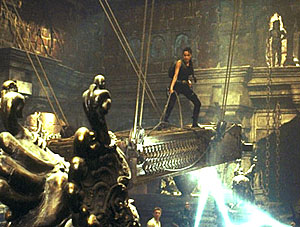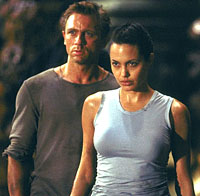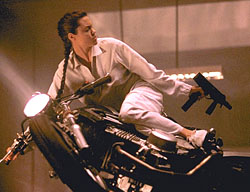

| |
| Excavating with Bullets | June 14, 2001 |
| by Mark Rose | |
With automatic weapons, is stratigraphy so important?

Angelina Jolie, as Lara Croft, in quest of the ancient key.
Opening this Friday is Lara Croft: Tomb Raider, a big-budget action movie from Paramount. The first five minutes--an Egyptian setting, lots of gun fire, and a homicidal robot--set the tone and pace for the rest of the film. The plot is simple: An alignment of all nine planets plus a solar eclipse takes place in one week. In that time Lara Croft, played by Angelina Jolie, has to find a missing key, racing a secret society known as the Illuminati to gain possession of it. A disk with ancient-looking engravings (an Egyptian protective eye motif is prominent), the key was forged during the last such alignment 5,000 years ago. The amulet gave power over time to the inhabitants of a lost city, a heavily tattooed people to judge by the one who appears on screen. Abuse of the key led to the destruction of the city, located in Iceland but looking like a Khmer-Mesoamerican hybrid. To prevent its future misuse, the key was broken in half and hidden. The Illuminati are apparently heirs of the original bad guys from 5,000 years ago, and if they get their paws on the key we're all in big trouble.
The movie is based on the Lara Croft character from the Tomb Raider video game by Eidos Interactive. Paramount, which is owned by Viacom, hopes the film will capitalize on the video game's popularity--since its 1996 debut, it has sold more than 21 million units, pulling in over $500 million, and has over 1,000 fan sites on the web. The video game has been featured in Time, Newsweek, Rolling Stone, Entertainment Weekly, and Details magazines. Angelina Jolie appears on the Entertainment Weekly cover coinciding with the film's opening. Lara Croft has yet to appear in academic publications such as the American Journal of Archaeology, Antiquity, and Archäologische Anzeiger. On the other hand, the video game is popular among anthropology and archaeology students and Lara Croft is said to be a favorite at Halloween costume parties on campus.
What's the literary and cinematic heritage of the Lara Croft character and Tomb Raider approach to archaeology? I think you can trace it through the Indiana Jones films and Jewel of the Nile, plus a dose of the Clint Eastwood character "Dirty Harry" with his penchant for using large guns to shoot things, to old smash-and-grab archaeology-adventure writing geared toward adolescent boys, like H. Rider Haggard's King Solomon's Mines. Lara Croft owes a bit to James Bond and to Emma Peel from the old Avengers television series, with maybe a hint of Edgar Rice Burroughs' Tarzan for the British nobility touch, the ape-man actually being Lord Greystoke. Supporting Lara Croft in the film are two stock characters, her butler (see Bunter from the Lord Peter Wimsey mystery novels and Jeeves from P.G. Wodehouse's Bertie Wooster stories) and a bumbling computer-geek inventor (see Q from the James Bond movies and Jerry Lewis in The Nutty Professor). For the film we also have the similarly stock ancient advanced people who fell into evil, bringing down their civilization (see Atlantis). |
 Our heroine and rival tomb raider Alex (Daniel Craig) |
Is there any real archaeology in the film? Most of what's there is backdrop, much of the film being shot at Angkor in Cambodia. (In an AP report, Jolie is quoted as saying, "It's the most amazing place I've ever been to in my life.") The only person identified in the film as an archaeologist, other than Lara Croft, works for an auction house, apparently supplying it with looted artifacts. There is an attempt in the script to give the Lara Croft character some depth, shown in her devotion to her deceased parents, especially her father, but it is swamped by other aspects of the video game's character: "Think James Bond crossed with Indiana Jones...in a Wonderbra" (Entertainment Weekly) and "a high-flying pinup version of Indiana Jones" (JAM! Movies). That's too bad. Not that this is really anything other than an action movie. As you might expect, the film credits are loaded with special effects, visual effects, and stunt people. My favorite on the credit list is Joss Skottowe, Weapons Supervisor. Not somebody you'd find on an archaeological field school. While preparing for her role, Jolie was said to be "on a strict training regimen of gymnastics, bungee jumping, kickboxing, weight training and the use of machine guns," according to an AFP report last September. Should we consider revising the archaeology curriculum on the university level?

Guns play a larger role in the movie Tomb Raider than in most excavations.
Okay, so this isn't the movie that puts real archaeology into an action film on the big screen. But the movie is very good as an action film and enjoyable as such. Maybe in the sequel--Angelina Jolie has signed on for one--we can work on the archaeology a bit.
| For more on the film, see the web site (www.tombraidermovie.com), where you can also buy official Tomb Raider merchandise! |
Mark Rose is executive editor of ARCHAEOLOGY.
Intro | Game Review | Your Reviews
© 2001 by the Archaeological Institute of America https://archive.archaeology.org/online/reviews/tombraider/movie.html |
Advertisement

Advertisement






